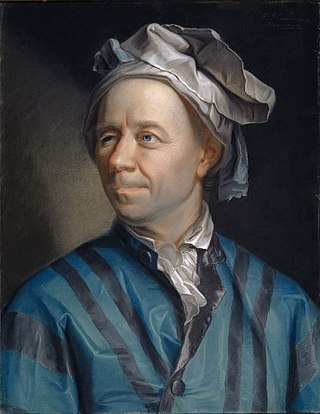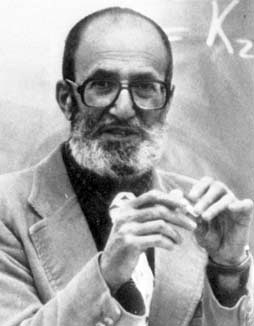
The number e is a mathematical constant approximately equal to 2.71828 that can be characterized in many ways. It is the base of the natural logarithm function. It is the limit of as n tends to infinity, an expression that arises in the computation of compound interest. It is the value at 1 of the (natural) exponential function, commonly denoted It is also the sum of the infinite series

Leonhard Euler was a Swiss mathematician, physicist, astronomer, geographer, logician, and engineer who founded the studies of graph theory and topology and made pioneering and influential discoveries in many other branches of mathematics such as analytic number theory, complex analysis, and infinitesimal calculus. He introduced much of modern mathematical terminology and notation, including the notion of a mathematical function. He is also known for his work in mechanics, fluid dynamics, optics, astronomy, and music theory.

Topology is the part of mathematics concerned with the properties of a geometric object that are preserved under continuous deformations, such as stretching, twisting, crumpling, and bending; that is, without closing holes, opening holes, tearing, gluing, or passing through itself.

In mathematics, Euler's identity is the equality

Joseph-Louis Lagrange, also reported as Giuseppe Luigi Lagrange or Lagrangia, was an Italian mathematician, physicist and astronomer, later naturalized French. He made significant contributions to the fields of analysis, number theory, and both classical and celestial mechanics.

Paul Richard Halmos was a Hungarian-born American mathematician and statistician who made fundamental advances in the areas of mathematical logic, probability theory, statistics, operator theory, ergodic theory, and functional analysis. He was also recognized as a great mathematical expositor. He has been described as one of The Martians.

In mathematics education, precalculus is a course, or a set of courses, that includes algebra and trigonometry at a level which is designed to prepare students for the study of calculus, thus the name precalculus. Schools often distinguish between algebra and trigonometry as two separate parts of the coursework.
The Carus Mathematical Monographs is a monograph series published by the Mathematical Association of America. Books in this series are intended to appeal to a wide range of readers in mathematics and science.

In geometry, Euler's theorem states that the distance d between the circumcenter and incenter of a triangle is given by
The 18th-century Swiss mathematician Leonhard Euler (1707–1783) is among the most prolific and successful mathematicians in the history of the field. His seminal work had a profound impact in numerous areas of mathematics and he is widely credited for introducing and popularizing modern notation and terminology.
Judith Victor Grabiner is an American mathematician and historian of mathematics, who is Flora Sanborn Pitzer Professor Emerita of Mathematics at Pitzer College, one of the Claremont Colleges. Her main interest is in mathematics in the eighteenth and nineteenth centuries.

Introductio in analysin infinitorum is a two-volume work by Leonhard Euler which lays the foundations of mathematical analysis. Written in Latin and published in 1748, the Introductio contains 18 chapters in the first part and 22 chapters in the second. It has Eneström numbers E101 and E102.
Carl Gottlieb Ehler is considered a mathematician, specifically due to his post as an astronomer in Berlin. He was mayor of the Prussian capital of Danzig from March 1741 until his death.
Harold Mortimer Edwards, Jr. was an American mathematician working in number theory, algebra, and the history and philosophy of mathematics.
Zero to the power of zero, denoted by 00, is a mathematical expression that is either defined as 1 or left undefined, depending on context. In algebra and combinatorics, one typically defines 00 = 1. In mathematical analysis, the expression is sometimes left undefined. Computer programming languages and software also have differing ways of handling this expression.
Margaret Bunting Wyman Tent, also known by her pen name M. B. W. Tent, was an American mathematics educator and writer. She was the author of several bestselling books.
The Beckenbach Book Prize, formerly known as the Mathematical Association of America Book Prize, is awarded to authors of distinguished, innovative books that have been published by the Mathematical Association of America (MAA). The prize, named in honor of Edwin F. Beckenbach, was established in 1983 and first awarded in 1985. The award is $2500 for the honored author and is awarded on an irregular basis. In January 1985 Charles Robert Hadlock was awarded the MAA Book Prize, which later in 1985 became the Beckenbach Book Prize.
Daniel "Dan" Simon Kalman is an American mathematician and winner of nine awards for expository writing in mathematics.







